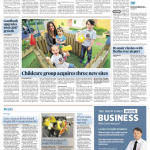Pól Ó Conghaile is an award-winning journalist, travel writer and author. Based in Dublin, he has written for CondeNet, Guardian/Observer, all major Irish broadsheets, Cara Magazine and The Globe and Mail, amongst other publications. Pól specialises in travel and features, contributes widely to national radio and TV, and was voted Irish Travel Journalist of the Year in 2003, 2004 and 2008. For more information on Pól check out www.irelanduncovered.ie or follow him on Twitter twitter.com/poloconghaile.
Pól talks to us about how he started in the business, who he is following online and his top tips for travel in 2011.
How did you get into writing and in particular, travel writing?
For me the problem wasn’t getting into writing. The problem will be trying to get out of it. I can’t imagine not writing and, as content goes cuckoo online, think the printed word has more of a place than ever. Travel writing and journalism I saw as a way to be curious, to see the world, and to get paid for doing it. It was a no-brainer.
What tips do you have for any budding travel journalist?
If you’re freelance, travel economically. Try to get several stories and angle from each trip, and several outlets that you can spread them across (without ever giving the same material to competing media). It’s a hard trick to pull off, but once you get the hang of it, it works. Also, don’t rely solely on travel. Budgets are small in travel editorial, so though you may get paid for your story, you won’t get paid for any time spent travelling. Have a back-up.
What is an average working day in the life of Pól Ó Conghaile like?
There are two average working days in my life. One is on the road. It involves getting up at the crack of dawn and either taking trains, planes and automobiles to the far (and near) ends of the earth, stuffing in as many places I can, and keeping my notes and photos ticking over on the laptop as I go. The other is at my desk. I try to keep that as 9-5ish as possible, pounding out the words in as disciplined a fashion as I can. It doesn’t sound very romantic, writing in business hours to strict wordcounts, but with writing, the romance isn’t in the hours. It’s on the page.
How much of your work involves dealing with PR practitioners?
PR is a small but essential part of the media mix. They are pushing products, but loathe as journalists can be to admit it, those products sometimes make very good stories. The trick is to remember you’re writing editorial. Not advertorial. That’s the only way to keep readers onside, and keep yourself sane.
In your opinion, how can PR practitioners best serve travel media?
By sending short, targeted ideas on a considered basis. Also, if a PR is working with a travel journalist on the ground, (s)he needs to be careful to be flexible with itineraries. PRs can end up juggling clients (who want the journo to see every church and hotel room in the country) and the journo (who has his own and his readers’ interests). The best result is somewhere in between. Oh, and always have hi-res images.
You have your own blog. Which blog platform do you use for this and why?
Wordpress. I took advice from several bloggers and IT colleagues before setting up, and their advice was pretty unanimous. I’m not a techie, so I went with it. It was a pain to set up, but runs smoothly now. I use it across my desktop, laptop and iPhone.
What are your top five tips for successful blogging?
- Blog regularly
- Blog smart
- Find a niche
- Interact with other bloggers
- Budget your time
Would you recommend that all journalists have a blog of their own?
No. Blogging suits some, but it definitely doesn’t suit others. A blog can add huge value to a journalist’s offline output, but only if it is smartly compiled and updated when readers expect.
What blogs do you follow?
Several. On travel I’ll keep up with everything from truth.travel to jaunted.com, HotelChatter and Carry On. The Huffington Post’s travel section is colourful, to say the least. Otherwise, I’ll check in with the Irish Times blogs, global stars like Andrew Sullivan, and I keep an eye on developing stuff like Storyful and Broadsheet.ie. Journalists read very widely, or should I say, ‘skim’ very widely.
How important do you think Twitter is to journalists?
Very. There are lots of Irish journalists on Twitter, using it for fun, to supplement their offline work, to shout out for story leads or case studies, and of course to boost their own profile. It’s a great tool… provided you use it cautiously. Otherwise it can be a serious distraction.
What are your dos and don’ts for using Twitter?
If you are contacting a journalist, do not spam or stalk. Do send targeted replies or DMs. Watch out for any calls for leads or case studies, and reply economically. Twitter has such a high noise-to-signal ratio, anyone who is spamming up the joint is quickly un-followed. That’s my take, anyway.
When you travel, what can you not do without?
My laptop, camera (Nikon D200… I’m waiting for the D400 to upgrade), my moleskin notebook, a couple of sachets of Dioralyte (for dehydration), sunscreen, my rechargers and adapters. Oh yes, and some spare clothes.
What do you predict will be the top travel trends for 2011?
If the weather’s good, it will be staycations all the way. Though we are going to see more Irish hotels closing down (you’d close down too, if a zombie ate your client base). We won’t be going back to the kind of holiday portfolios we cultivated in the Celtic Tiger years for some time – though I would think the odd city break might be due a return. If you can travel mid-week, there are some awesome deals out there. Otherwise, expect long-haul airlines to start charging like Ryanair, expect Ryanair to continue charging like Ryanair, and get ready for in-flight mobile phones and internet.





